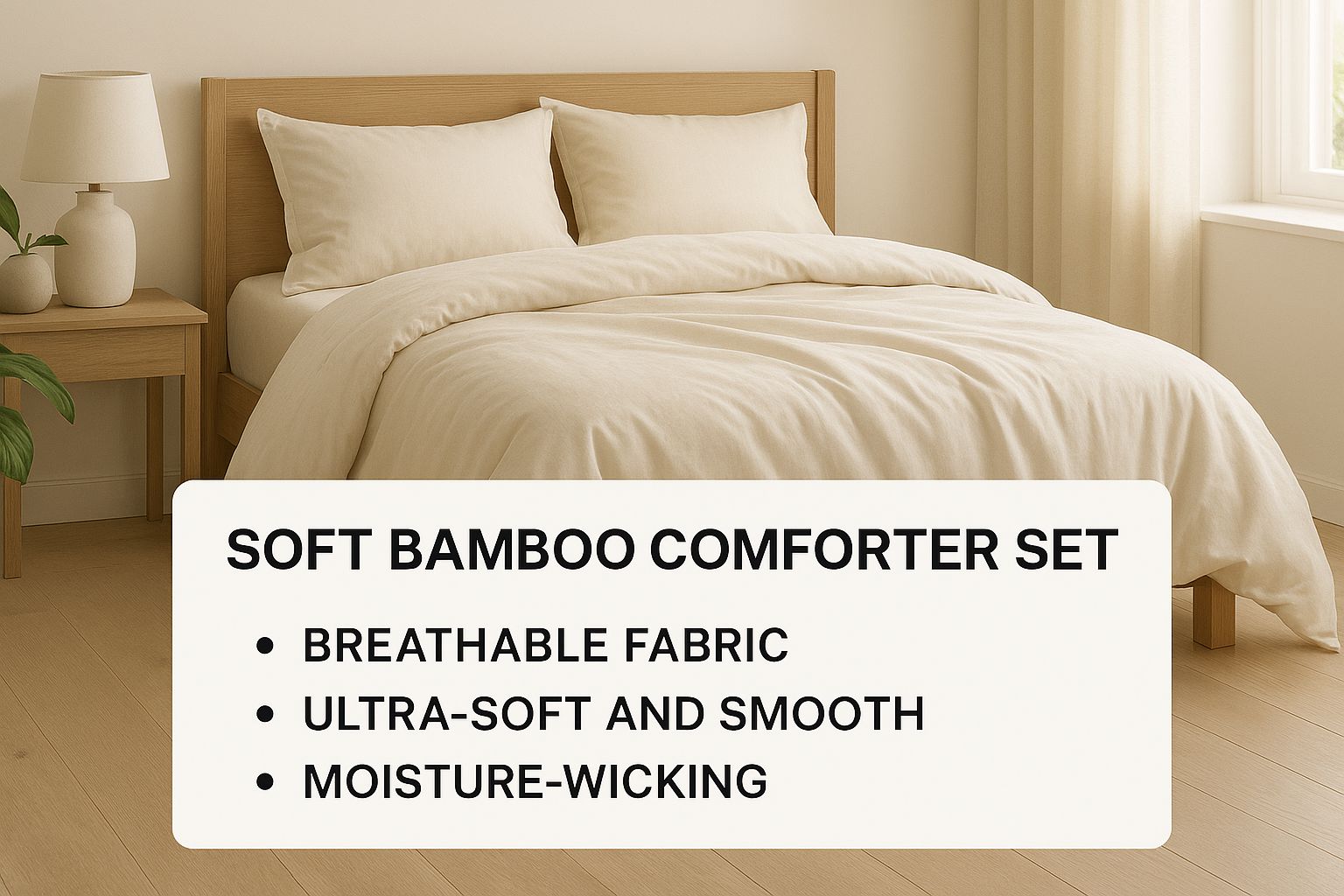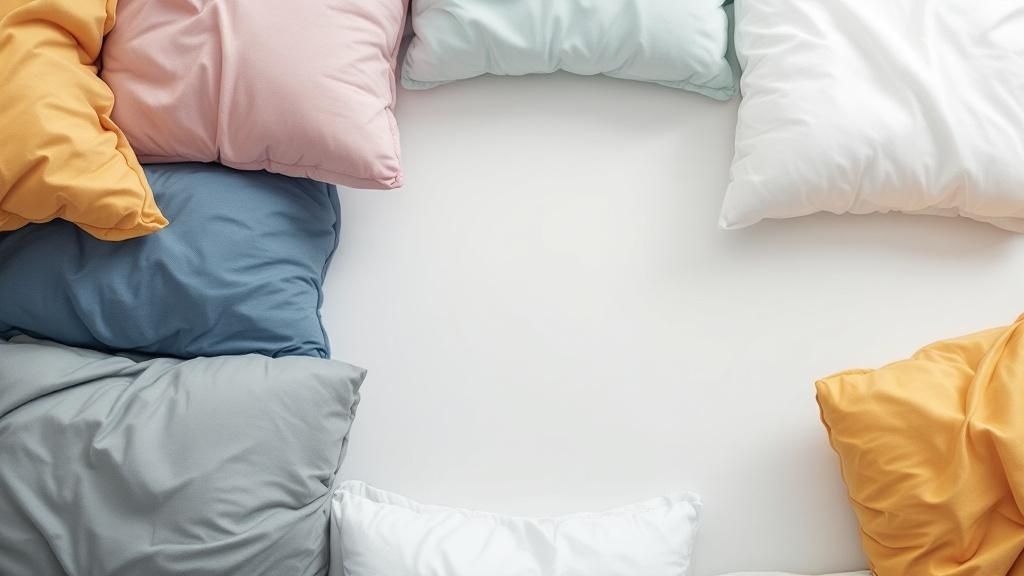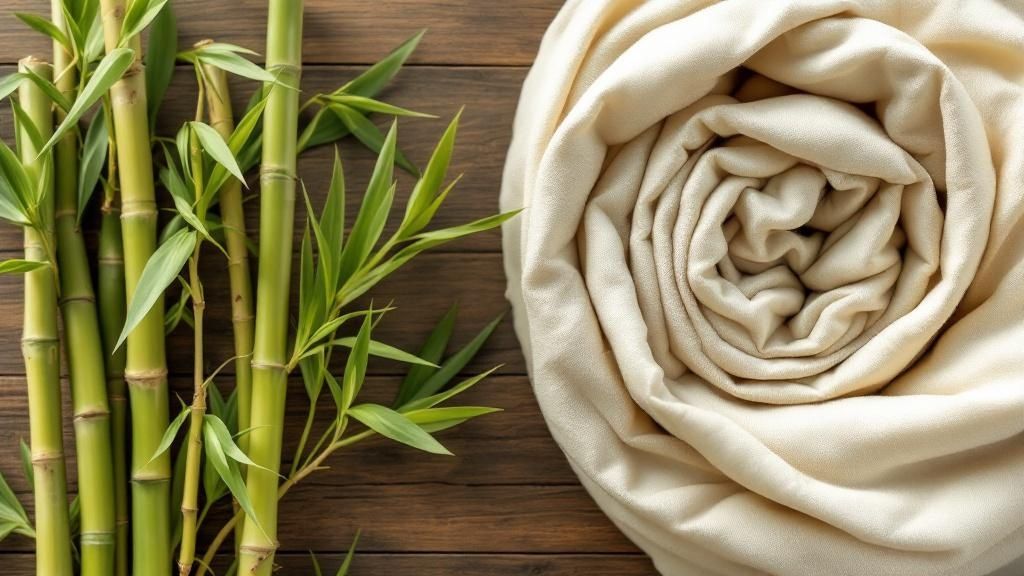Choosing a quality bamboo comforter set isn't just about buying new bedding—it's a real investment in your nightly health and well-being. The incredible softness and temperature control you get can genuinely change the way you sleep, which is why so many people are making the switch.
Why a Bamboo Comforter Can Truly Transform Your Sleep
We all want better, more refreshing sleep. A lot of products make big promises, but a bamboo comforter often delivers by working with your body, not against it. This isn't just clever marketing; it all comes down to the natural properties of the fabric itself.
The biggest win here is bamboo's amazing ability to regulate temperature. Its fibers are naturally breathable and full of micro-gaps, which lets them pull moisture and heat away from you way more efficiently than old-school cotton.
- If you’re a hot sleeper: You know that feeling of waking up sweaty and uncomfortable? Bamboo fabric wicks that heat and moisture away, creating a cooling effect that keeps you dry and comfortable all night long.
- If you’re a cold sleeper: In the winter, those same fibers work as a fantastic insulator. They trap your body heat to keep you perfectly warm and cozy, but without the heavy, suffocating feel of thick synthetic blankets.
This built-in thermoregulation means a bamboo comforter set is a genuine all-season solution. It adapts to what you need, whether it's the middle of summer or the dead of winter.
A Whole New Level of Soft, Skin-Friendly Comfort
Beyond keeping you at the perfect temperature, the feel of bamboo is just incredible. It's exceptionally soft and silky—many people say it feels like high-end cashmere or silk.
This makes it an absolute dream for anyone with sensitive skin or conditions like eczema because the smooth fibers won't chafe or irritate. If you've ever found yourself fighting with scratchy bedding, this is a total game-changer. The link between great rest and your overall health is crystal clear, and you can dive deeper into the connection between sleep and your health in our detailed guide.
The buzz around bamboo bedding isn't just talk. The global bed linen market saw a compound annual growth rate of approximately 5.1% between 2019 and 2024. A lot of that growth is thanks to new weaving technologies that have made bamboo's natural thermoregulating properties even better, solidifying its spot as a top choice for shoppers. You can read more on these bed linen market trends to see the data for yourself.
How to Decode Bamboo Fabrics and Weaves
Walking into the world of a bamboo comforter set can feel like learning a new language. You'll see terms like "viscose," "lyocell," "sateen," and "twill" tossed around, but what do they actually mean for your sleep? Getting a handle on these terms is the secret to finding a comforter that feels just right.
The most common fabric you'll see is viscose from bamboo. This is made by dissolving bamboo pulp and spinning it into the soft, silky fibers that give bamboo bedding its signature luxurious, cool-to-the-touch feel. You might also spot bamboo lyocell, which uses a more sustainable, closed-loop process. Both are incredibly soft, but the eco-friendly production often gives lyocell a higher price tag.

The right set, like the one pictured, drapes beautifully and has a subtle sheen that just screams comfort. It’s that premium quality you get when you know what to look for in the fabric and weave.
Sateen vs. Twill: What’s the Difference?
Beyond the type of fiber, how it's woven together makes a huge difference in the final feel. The two main players you’ll find in a bamboo comforter set are sateen and twill, and they offer completely different experiences.
-
Sateen Weave: If you love that silky, almost slippery feeling, sateen is for you. It’s made with a one-under, three-or-four-over weave pattern. This puts more threads on the surface, creating an exceptionally smooth fabric with a beautiful, subtle luster. It glides over your skin and feels fantastic for hot sleepers.
-
Twill Weave: Think of the diagonal rib on your favorite pair of jeans—that's a twill weave. This structure gives the fabric excellent durability and makes it less prone to wrinkling than sateen. It has a slightly more textured, cozier hand-feel while still delivering that classic bamboo softness.
Expert Tip: Your choice between sateen and twill is all about personal preference. For a slick, cool, and lustrous feel, go for sateen. If you want something durable, cozy, and wrinkle-resistant with a bit more texture, twill is a fantastic choice.
To make it even easier, here’s a quick breakdown of how the weaves compare. Use this to pinpoint the exact texture and performance you want from your comforter.
Comparing Common Bamboo Fabric Weaves
| Weave Type | Feel & Texture | Ideal For Sleepers Who |
|---|---|---|
| Sateen | Silky, smooth, and lustrous. Glides over the skin. | Prefer a cool, slick surface and a luxurious, satin-like feel. |
| Twill | Soft but with a subtle diagonal texture. Drapes well and is very durable. | Want a cozier, slightly textured feel that is durable and resists wrinkles. |
Ultimately, knowing the difference between these fabrics and weaves gives you the power to look at any product label and know exactly how that bamboo comforter set will feel night after night.
What to Look For in a High-Quality Bamboo Comforter Set
When you're ready to invest in a bamboo comforter set, it's easy to get lost in the details. But a few key features separate a decent set from a truly exceptional one that will feel like a long-term investment in your sleep. It's about more than just the fabric; the real quality is in the craftsmanship and the materials themselves.

The first thing I always check for is third-party certifications. Seeing the OEKO-TEX STANDARD 100 label gives you confidence that every single part of the comforter—right down to the thread—has been tested and found free of harmful substances. For me, that's non-negotiable. It’s peace of mind wrapped in comfort.
This growing consumer awareness of quality and safety is a big deal. In fact, the global comforter market is expected to rocket past USD 5 billion by 2025. Bamboo sets are a huge part of that surge, largely because people are actively seeking out their hypoallergenic and temperature-regulating perks. You can dig deeper into these comforter market trends to see how shopper priorities are changing the game.
Construction That Stops Clumping
Ever owned a comforter where the filling shifts around, creating annoying lumps and cold spots? It’s a common complaint, but one that quality construction completely avoids. The secret lies in baffle-box stitching.
This design creates a grid of individual pockets across the comforter, locking the fill into place. The result is an even layer of warmth and fluffiness that stays put, wash after wash. It’s a small detail that makes a world of difference in how your bedding feels and performs over time.
My Personal Tip: I never buy a comforter unless it has baffle-box or a similar sewn-through construction. It’s the single most effective feature for preventing that dreaded clumping, which is my biggest pet peeve. It's what keeps the comforter feeling like an even, fluffy cloud.
The Best Materials for the Fill
What's inside your comforter is just as crucial as the outer shell. To get the full benefit of bamboo, the fill needs to work in harmony with the fabric.
Here’s what to look for:
- 100% Bamboo Viscose Fill: This is the premium choice. It gives you maximum breathability and softness, perfectly matching the thermoregulating magic of the shell.
- Down-Alternative Microfiber: A top-notch synthetic option can also be fantastic. It provides that lofty, plush feel and is great for allergy sufferers, often at a slightly lower price.
By keeping an eye out for certifications, checking the stitching, and knowing what's inside, you can pick a bamboo comforter set you’ll absolutely love for years to come.
The Real Impact of Bamboo on Health and Planet
https://www.youtube.com/embed/SdGyQo3m64s
Choosing a bamboo comforter set is about so much more than just a good night's sleep. For a lot of people, myself included, it’s a conscious choice that touches on personal health and our impact on the environment. There’s a real satisfaction in knowing your bedding aligns with your values.
It all begins with the remarkable bamboo plant. This isn't your typical crop. Bamboo is one of the fastest-growing plants on Earth, and it thrives without demanding massive amounts of water or chemical pesticides. This stands in stark contrast to traditional cotton, which is notoriously thirsty and often relies on heavy chemical intervention. When you opt for bamboo, you're directly supporting a more sustainable, earth-friendly way of doing things.
A Healthier Sleep Environment
Beyond its impressive green credentials, bamboo offers some very real benefits for your health. The fibers are naturally hypoallergenic, which is a lifesaver for anyone dealing with allergies or sensitive skin. Unlike other fabrics that can become a haven for dust mites and other allergens, bamboo naturally keeps them at bay.
I've heard countless stories from people with eczema or persistent allergies who found incredible relief after making the switch. The fabric's silky-smooth texture doesn't chafe or irritate the skin, leading to a much calmer and more restorative rest.
The bottom line is that bamboo bedding helps you create a cleaner sleep sanctuary. Its natural properties actively reduce common irritants, making it an incredibly smart choice for anyone prioritizing their well-being.
This isn't just a niche trend; it reflects a major shift in what people want. The global home bedding market was valued at USD 104.64 billion in 2023 and is projected to climb to USD 172.36 billion by 2030. A huge driver of this growth is the increasing demand for hypoallergenic and eco-friendly products like bamboo. You can discover more insights about home bedding market trends to see how these priorities are reshaping the entire industry.
On top of all that, bamboo is well-known for its antibacterial qualities. The plant contains a natural agent that resists bacterial growth, which means your bedding stays fresher for longer. This translates to fewer odors and a more hygienic place to rest your head each night. You can learn more about the antibacterial benefits of bamboo sheets right here on our blog.
Keeping Your Bamboo Comforter Like New

You’ve invested in a luxurious bamboo comforter set, and I'm sure you want to keep that signature cloud-like softness for as long as possible. The good news is, it's pretty simple. The main thing to remember is that bamboo fibers are more delicate than something like cotton, so they just need a gentler touch.
Washing Your Bamboo Comforter
From my own experience, the most important part of the routine is the wash cycle. You'll want to use cold water exclusively, set to a gentle or delicate cycle. Hot water is the enemy here; it can make those fine bamboo fibers shrink and lose their strength over time. Sticking to cool temperatures is probably the single best thing you can do for your comforter.
When it comes to soap, a mild, liquid detergent is the way to go. Harsh chemicals, bleach, and even some gritty powdered detergents can be too abrasive for the fabric. Treat it like you would silk—the gentler, the better.
I can't stress this enough: never use fabric softener. It might seem like a good idea, but fabric softeners actually coat the fibers in a waxy film. This residue can break down the bamboo and, worse, clog the microscopic pores that make it so breathable and good at wicking away moisture. Your comforter is already incredibly soft, I promise!
The Secret to Fluffy Drying
Now for drying. The key is low and slow. Tumble dry your comforter on the absolute lowest heat setting your dryer has.
Here’s a pro tip I swear by: toss in a few wool dryer balls. They're fantastic for preventing the fill from bunching up and they really help speed up the drying time, all while keeping the comforter perfectly fluffy and even.
For a deeper dive into maintaining your entire bedding collection, check out our comprehensive guide on how to care for your bamboo sheets, as many of the same principles apply. Following these straightforward practices will make sure your investment continues to reward you with incredible sleep, night after night.
Still have a few questions before making the switch to bamboo? That’s completely normal. Making a change to something as personal as your bedding is a big deal, and it's smart to have all the facts.
Let's walk through some of the most common questions I hear from people who are considering a bamboo comforter set.
Are They Really a Good Year-Round Comforter?
Yes, they absolutely are—and this is probably their biggest selling point. It all comes down to the unique structure of bamboo fibers. They're incredibly breathable, so in the summer, they let your body heat and sweat escape. No more waking up sticky and hot.
Then, when the weather turns cold, those same fibers trap a thin layer of your body heat, creating a perfectly cozy microclimate. You get all the warmth you need without feeling weighed down or smothered like you can with some bulky down comforters. It's a single comforter that genuinely adapts to every season.
How Can I Tell a High-Quality Set from a Cheap Knock-Off?
This is a great question. With bamboo's popularity, a lot of subpar products have flooded the market. Here's what I look for to spot the real deal:
- Check the Tag: It should clearly state 100% bamboo-derived material (like viscose or lyocell). If you see a polyester or microfiber blend, you're not getting the full benefits. The pure stuff is what you want.
- Look for Certifications: The OEKO-TEX STANDARD 100 label is non-negotiable for me. It’s an independent certification that ensures the fabric is free from harmful substances, which is critical for anything that's going to be against your skin all night.
- Examine the Stitching: A quality comforter will have baffle-box construction. This means the comforter is stitched into a grid of individual squares, keeping the fill locked in place.
Without that baffle-box design, the filling will inevitably shift and clump, leaving you with cold spots and lumpy sections. It’s a small detail that makes a huge difference in comfort and longevity.
Is a Bamboo Comforter Set Worth the Price Tag?
For most people, the answer is a definite yes. While the upfront cost is often higher than a basic cotton or polyester comforter, you're not just buying bedding; you're investing in your sleep.
Think about it: you're getting incredible softness, game-changing temperature regulation (especially for hot sleepers or couples with different temperature needs), and hypoallergenic properties. Add in the fact that a well-made bamboo comforter is incredibly durable with the right care, and it quickly becomes a worthwhile long-term investment in better, more restful nights.
Ready to feel the difference for yourself? Take a look at the premium, 100% organic collection at Bamtek to see what truly great sleep feels like. Find your perfect bamboo comforter set today at bamtekhome.com.










